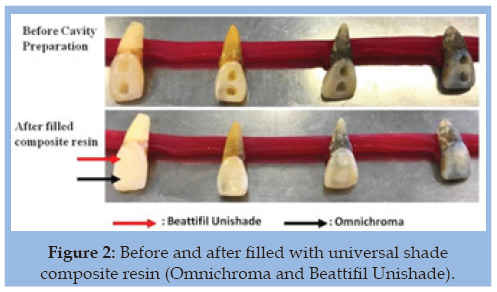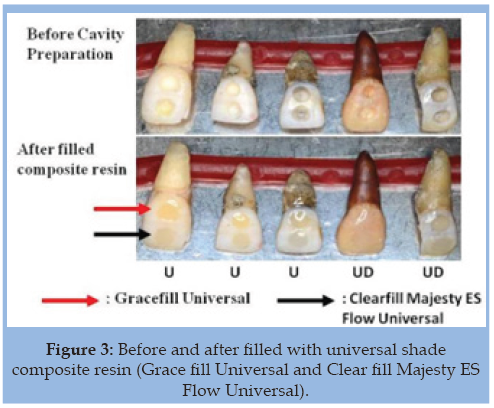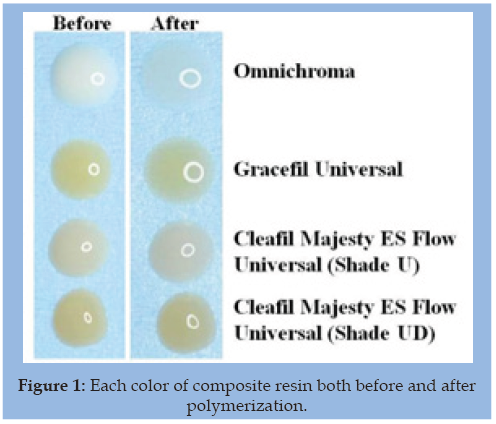
Lupine Publishers Group
Lupine Publishers
Menu
ISSN: 2637-4692
Mini Review(ISSN: 2637-4692) 
Advantages and Precautions of Universal Shade Composite Resin Volume 5 - Issue 3
Yoshishige Yamada*
- Division of Operative Dentistry, Department of Conservative Dentistry, Ohu University School of Dentistry, Japan
Received: July 11, 2022; Published: July 20, 2022
Corresponding author: Yoshishige Yamada, Division of Operative Dentistry, Department of Conservative Dentistry, Ohu University School of Dentistry, Japan
DOI: 10.32474/MADOHC.2022.05.000215
Introduction
Composite resin has produced as an esthetic material around since the 1960s. To attain that the composite resin matches the surrounding natural teeth, shade matching is a very important process. Human teeth show variety of colorations depending on age, race, and other factors. Therefore, shade matching is difficult and time-consuming process. Recently, universal shade composite resin has been developed that can cover VITA classical A1 to D4 shade guide in one shade. The first advantage of this resin is that shade matching before filling the composite resin is not required. Although shade matching is performed with VITA classical shade guide generally, some cases show hard to match between the tooth color and the composite resin. Therefore, the allowing omit the shade-matching process reduces chair time on a procedure and eliminates the need to consider the risk of technical errors during shade matching. The second advantage is that there is no need to keep numerous shades of composite resins for treatment. To treatment using conventional composite resins, it is necessary to always have several shades of composite to accommodate patients with various shades of tooth color. Therefore, it should be a significant economic advantage to prepare only one shade composite resin.
Universal Shade Resin
Omnichroma (Tokuyama Dental, Japan) was marketed as first universal shade resin, followed by several similar products. While conventional composite resins rely on dyes and pigments to match specific shades, universal shade composite resins are using structural colors to develop colors as matching patient’s natural teeth. Structural color does not owing to pigments or dyes but is expressed by interacting visible light and nanostructures that range in size between microscopic and molecular-sized (They are not able to be confirmed by visible eyes). In other word, Structural color is relay on the reflection of light through these tiny, physical structures. The reflection of light thorough nanostructures is different from reflection by normal structure like as visible scale.
For example, some reflection of light through nanostructure shows blue or yellow even the original color of nanostructure is other colors and the colors visible to the eye from the reflected light are depending on the size of the nanostructure [1]. The natural teeth color that was shown A1 to D4 colors in the VITA classical shade guide fall in the range of red to yellow color, and universal shade composite resins utilize a nanostructures sized to reflect red to yellow light. Therefore, they are able to create colors without pigments and dye. According to this principle, Omnichroma has been using the uniquely produced uniform 260 nm size nanofiller that can induce red to yellow coloration without the use of dyes or pigments. Other universal shade composite resins have been containing non-uniformed nanofiller that are crushed glass materials milled to a particular size, and they have been slightly containing pigmentation and dye. For that reason, the results of colorization after light-polymerization are not same color of all universal shade composite resin, but some universal composite resin shows whitely and other resins are seen tendency reddish coloration (Figure 1).
Precautions For Use
Figure 2: Before and after filled with universal shade composite resin (Omnichroma and Beattifil Unishade).

Figure 3: Before and after filled with universal shade composite resin (Grace fill Universal and Clear fill Majesty ES Flow Universal).

Actually, the results of filled with universal shade composite resins into the cavities after cavity formation in the human natural teeth that were provided by the patient with consent to be used in the study showed sufficient matching vita shade A color and C color by Omnichroma and Beattifil Unishade (Shofu Inc, Japan). However, it was visible more whitely after filled with B color shade and D color shade crown (Figure 2). While after filling Clear fill Majesty ES Flow Universal (Kuraray, Japan) and Grace fill Universal (GC, Japan) appeared slightly reddish colored and not adequately match the surrounding A and C color tooth. On the contrary, these composite resins seem to be matching for B colored tooth crown (Figure 3). Although these results are not a perfect reproduction of the actual intraoral environment because of the situation with extracted teeth, it is possible that the use of universal shade composite resin may not be obtained the expected results in some cases. Unfortunately, it seems that there is no universal shade composite resin with completely matching all color of VITA classic shade guide at the moment. From these results, it is necessary to consider sufficiently for the characteristics of each universal shade composite resin before they use.
Conclusion
Universal shade composite resin is able to adapt the many shades of tooth restorations with a single shade composite resin. Then this composite resin will be a new direction for composite resin, and several new universal shade composite resins which improve on current problems are expected to be marketed in a future. Therefore, at this stage, it should be considered universal shade composite resin might not be suitable for all cases.
Conflicts of Interest
There are no conflicts of interest. Conflict of interest statement. The author has declared that no competing interests exist.
References

Top Editors
-

Mark E Smith
Bio chemistry
University of Texas Medical Branch, USA -

Lawrence A Presley
Department of Criminal Justice
Liberty University, USA -

Thomas W Miller
Department of Psychiatry
University of Kentucky, USA -

Gjumrakch Aliev
Department of Medicine
Gally International Biomedical Research & Consulting LLC, USA -

Christopher Bryant
Department of Urbanisation and Agricultural
Montreal university, USA -

Robert William Frare
Oral & Maxillofacial Pathology
New York University, USA -

Rudolph Modesto Navari
Gastroenterology and Hepatology
University of Alabama, UK -

Andrew Hague
Department of Medicine
Universities of Bradford, UK -

George Gregory Buttigieg
Maltese College of Obstetrics and Gynaecology, Europe -

Chen-Hsiung Yeh
Oncology
Circulogene Theranostics, England -
.png)
Emilio Bucio-Carrillo
Radiation Chemistry
National University of Mexico, USA -
.jpg)
Casey J Grenier
Analytical Chemistry
Wentworth Institute of Technology, USA -
Hany Atalah
Minimally Invasive Surgery
Mercer University school of Medicine, USA -

Abu-Hussein Muhamad
Pediatric Dentistry
University of Athens , Greece

The annual scholar awards from Lupine Publishers honor a selected number Read More...





